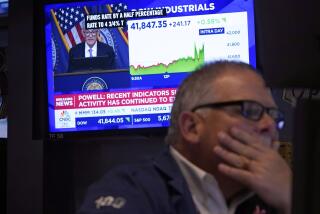Prime Rate Cut to 10% by Bank, Lowest Since â78
The nationâs seventh-largest bank lowered its prime lending rate on Wednesday by half a percentage point to 10%, the first adjustment since mid-January and the lowest rate in more than six years.
The move by Bankers Trust New York was not followed by other major banks, which appeared to be taking a more cautious view of money markets and federal monetary policy. Analysts said that an eventual decline in the prime was expected but differed on whether it signaled a further slowing of the economy.
âItâs no great surprise,â Charles Steindel, senior domestic economist at First Chicago Corp., said of the move by Bankers Trust. âShort-term interest rates have been going down for several weeks.â
He said he believed that the economy would remain sluggish through the end of the year, which should cause interest rates to remain stable or continue to drop.
Falling Regularly
The prime has been falling regularly since last September, when it was at 13%. It has not been at 10% since October, 1978, when it began climbing to a peak of more than 20% in late 1980.
Bankers Trust said that it lowered its benchmark rate in response to a drop in its cost of funds.
âIt seemed to us that the prime rate should reflect that decline,â Vice President Thomas Parisi said. The rate change is effective today.
The prime rate is the base rate on which most business loans are calculated. The most credit-worthy corporate borrowers pay less, and smaller businesses pay a higher rate based on the estimated risk of the loan.
The rate is closely watched by corporate money managers and is important to Third World borrowers, many of whom pay interest rates pegged to the prime. Consumer loans are not directly linked to the prime rate, but some analysts said that a falling prime could foreshadow a slight drop in rates for auto, home and personal loans.
Some small banks lowered their prime rate to 10% or 10.25% earlier this year, but the major institutions have held firm at 10.5% since Jan. 15.
The only other bank to follow Bankers Trustâs lead Wednesday was Mitsui Manufacturers Bank, the Los Angeles-based subsidiary of a major Japanese bank.
Major Banks Waiting
Other major banks refused to say whether they intend to follow suit, but chief economist Irwin Kellner of Manufacturers Hanover said, âBankers (Trust) could be out there by themselves for a little while. The other money center banks wonât be quick to follow until they see what will happen with other interest rates.â
He said that most banks are waiting for a signal from the Federal Reserve Board on whether it intends to cut the discount rate, the rate that it charges banks for short-term borrowing.
âThere is every reason to anticipate lower interest rates,â Kellner said. âBut the Fed isnât at a point where it feels a need to move precipitously. On balance, the Fed seems satisfied with the current state of the economy.â
Mortgage Rates Down
Although consumer loan rates are not based on the prime, they have generally been inching downward along with it. Average new home mortgage rates have fallen from a high of more than 16% four years ago to just under 13% today.
Interest rates paid to depositors also have been declining. Banks are paying an average annual yield of 7.65% on money market accounts as of this week, down from about 8% in February, according to the newsletter Bank Rate Monitor.
âReductions in consumer lending rates are overdue,â Monitor publisher Robert Heady said. âThis prime rate cut could provide the impetus for rate reductions across the board.â
A decline in the prime generally signals slack loan demand, an indicator of a sluggish economy. Although the service and financial sectors are doing well, farmers, manufacturers and exporters are suffering.
Production Declines
There was further evidence of the economyâs sluggishness Wednesday as the Federal Reserve Board reported that U.S. industrial production fell 0.2% in April, the first decline in six months. The central bank said that its index of the total output of the nationâs factories, mines and utilities fell for the first time since a 0.4% drop last October.
Charles Larson, an economist at the New York consulting firm of A. Gary Shilling & Co., said that the prime could fall even further as businesses pursue a more conservative borrowing strategy.
âWe do not feel that 10% is the floor,â he said. âIt could definitely go below that before the year ends.â
More to Read
Inside the business of entertainment
The Wide Shot brings you news, analysis and insights on everything from streaming wars to production â and what it all means for the future.
You may occasionally receive promotional content from the Los Angeles Times.










